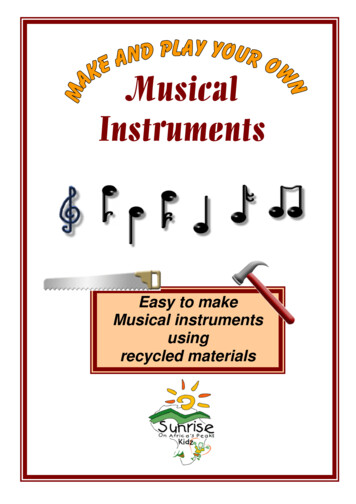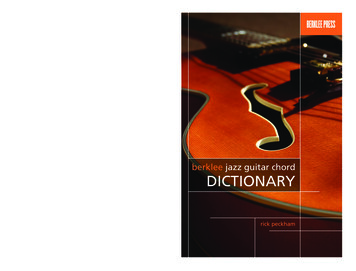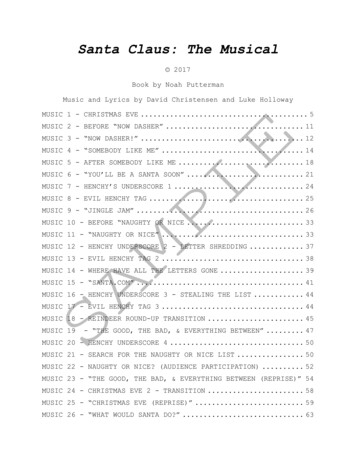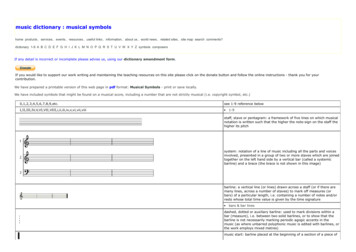
Transcription
MusicalInstrumentsEasy to makeMusical instrumentsusingrecycled materials
2
TABLE OF CONTENTS:1. DECORATIVE ITEMS52. DRUMSTICKS AND MALLETS62.1.2.2.66HARD ENDSSOFT ENDS3. PERCUSSION INSTRUMENTS73.1.3.2.CYMBALSCARDBOARD BOX DRUMS3.3. BOX DRUM3.4. BALOON TOM-TOM DRUM3.5. XYLO-DRUM3.6. COFFEE CAN BONGOS3.7. PAN DRUM3.8. MOUTH DRUM3.9. CAKE TIN HAND DRUM3.10. LOG DRUM3.11. SKIN DRUM3.12. TWO-SIDED SQUARE DRUM3.13. XYLOPHONE3.14. GONG3.15. CARPET-TUBE BONGOS3.16. TABULAR GLOCKENSPIEL7789910101111121213141415164. SHAKERS, RATTLERS AND INGLING JOHNNIE, LAGER PHONE, DOLLEY STICKMARACASTAMBOURINECLATTER STICKRATTLERGOURD SCRAPER (FOR WHEN YOU DO NOT HAVE GOURDS)CALABASHGOURD RATTLEHAWAIIAN ULI-ULINAIL RASPCHIMESSANDPAPER BLOCKSHAND BELLSFLOWER POT BELLS3
5.5.1.5.2.5.3.5.4.5.5.5.6.5.7.WIND INSTRUMENTSCOMB BUZZERFLUTE (PLUMBER’S PIPE CROSS)HORNKAZOO (TUBE)OBOE (STRAW) (SEE FIGURE 2)TRUMPET (GARDEN HOSE)WHISTLE (CLAY)26262626272728286. STRINGED INSTRUMENTS296.1. GUITAR6.2. MOUTH BOW (SEE FIGURE 1)6.3. SPIKE FIDDLE6.4. MUSICAL BOW6.5. PLASTIC BOTTLE BANJO29293032337. ACKNOWLEDGEMENT354
1. Decorative itemsFor any of these activities, you can leave the items plain or decorate them. If youneed ideas for decorating these projects, try any of the following items. We aresure this list will help you think of even more items you can use. Combine differentthings such as buttons and glitter or sequins and yarn. Let the children's creativitysurprise you!Keeping items such as these in a large plastic storage container makes for easyaccess and quick clean up.Sequins, buttons, yarn, ribbon, masking tape, beads, glitter, sand, cellophane,construction paper, magazines, photos, crayons, markers, colored pencils, paint,nail polishHave fun and let creativity and imagination run wild!Record the band's first song and play back for somegreat giggle time.Enjoy!5
2. Drumsticks And MalletsThese sticks and mallets may be used on many percussion instruments. It isimportant that the mallet be matched to the instrument so that it will feel "right" inthe hand and give the desired sound.Materials:Sticks, 1/4" to 1/2" doweling from 8" to 12" long, Chopsticks, Tree stems2.1.Hard Ends Take about a foot of 1/2" doweling and carve a broad groove about 5/8" fromthe end. Sand the ends round, wax (A). Wooden beads drilled out to fit a 1/4" dowel or stick and glued together makegood hard mallets (B). Cork that is carved in a round shape or old cork fishing floats fitted to a dowelor stick are also fine beaters. Plastic balls or spools may be glued to a stick.2.2.Soft Ends On about one foot of doweling wrap and wind yarn or jute twine as tight aspossible until it reaches a diameter of approximately 1". Dab the yarn endcompletely with white glue. Hold for a few minutes and let dry thoroughlybefore using (C) (D). Wind a strip of felt around the end of a dowel dabbing a bit of white glue asyou wrap. Small rubber balls or erasers carved a round shape and drilled out to fit on theend of a thin dowel make good beaters. Cork, plastic, or wooden balls glued on a dowel and covered with felt, fur,leather, yarn, or other cloth material (such as wool) are excellent (E). Thecovering may be either glued into the core or wrapped around tightly and tiedjust under the knob with string or lacing (F).6
3. Percussion Instruments3.1.CymbalsMaterials:two matching pot coversyarn or ribbonTo make:Tie the ribbon or yarn around the handles of the pot covers.To play:Strike together to play.3.2.Cardboard Box DrumsMaterials:Empty oatmeal box with cover,yarn,pen,2 pencils,2 spools,construction paper ,crayonsTo make:1. Before beginning, you can decorate the oatmeal box with constructionpaper and/or crayons for a colorful effect.2. Place the cover on the box.3. Use a pen to make a hole in the center of the cover and in the center of thebottom of the box.4. Through these holes, pull a piece of yarn long enough to hang aroundchild's neck and down to their waist.5. For the drumsticks, place the spools at the ends of the pencils, secure withglue if necessary.To play:Beat to play.7
3.3.Box DrumFirst came the hollow log. Then the large slit drum,which evolved into this portable version. Fine hardwoodmakes a much better sound than plywood.Materials:4 pieces of wood, each 6" x 8". Hardwoods have a verynice sound. Any size will work nicely.saw. A coping saw is best, for the blade can beremoved for cutting the inside shapes.pencildrilltwelve 1 1/2" finishing nailshammerwhite gluemallet or drumstick(s)To make:1. Draw patterns on wood (see diagram A).2. Drill holes at each angle of each pattern; this is for inserting saw blade.3. With the saw, cut on the lines drawn.4. Glue and nail both together (B).To play:Lay box on any side. Using one or two drumsticks or a mallet, tap the differentareas of the box for different tonal patterns.8
3.4.Balloon Tom-Tom DrumMaterials:Juice can, oatmeal box, potato chip can, or other such container2 large balloons.2 heavy rubber bands,2 pencils with erasersTo make:1. Open both ends of the container for the drum body2. Cut small end off the balloons, this is the drum skin3. Stretch the closed end of the balloon over the drum body4. Hold balloon in place with the rubber band, smoothing out the wrinkles5. Repeat 1-4 for the other endTo play:Use the pencil as the drum stick3.5.Xylo-DrumMaterials:tin can, potato chip can, juice can or other such container to use as the drumbody.Styrofoam cup with a base that will fit snugly into the open end of the drum body,balloon,rubber band,3-6 nails of different sizes, long enough to reach from one side of the cup to theother,duct tape,stick.To make:1. Open both ends of the container for the drum body cut small end off theballoons, this is the drum skin stretch the closed end of the balloon overthe drum body hold balloon in place with the rubber band, smoothing outthe wrinkles.2. Lay out the nails, shortest to the longest then push them through the rim ofthe Styrofoam cup.3. Don't let them touch each other.4. Fit the base of the cup into the open end of the drum body and tape inplace.5. Make a striker by taping a nail to a stick.9
3.6.Coffee Can Bongos(See Figure 1)Materials:two coffee cans of different sizes with lids,2 wing nuts,2 bolts.To make:1. Open both ends of the cans.2. With a nail punch 2 holes in each can. Put the holes in a straight line oneon top of each other.3. Line them up so that the bolts will go from one can into the other.4. Put the bolts through the holes and add the wing nuts securing them.5. Decorate the drum bodies if you want to.6. Add the plastic lids for the drum heads. Could use inner tubing, browngrocery sack or other material for the drum head. If you use any of thesecut the material one inch larger than the drum body.3.7.Pan DrumMaterials:several cardboard tubes of a different lengths but the same diameter,stiff transparent paper ,glue,model airplane lacquer.To make:1. Decorate the tubes if desired.2. Cut drum heads out of the paper and glue it to each tube.3. Treat each drum head with lacquer as soon as the glue is dry. This willcreate tension.4. Fasten drums together using rubber bands, glue, staples or whatever.10
3.8.Mouth DrumMaterials:mouth and hands.To play:Open mouth slightly. Lightly hit your cheeks with your open hands. It works bestwhen your hands are straight and your fingers are together. Try changing theposition of the mouth for different sound: opening and closing, tightening lips.3.9.Cake Tin Hand Drum(See Figure 2)Materials:round cake or candy tin without the lid,inner tube,rawhide or heavy twine lacing.To make:1. Cut the bottom out of the tin and smooth any rough edges.2. Cut open the inner tube so you can have a large, long flat piece that willcover both ends of the tin3. Lay the tin on the inner tube and draw a circle around it. Turn the tin overand draw another circle connecting the two circles.4. Cut the two circles out like a figure eight, so they are connected.5. With the paper punch make holes all the way around the edges about oneand a half inches apart.6. Pull this "drum head" over the tin so that the open end meets, tie this downuntil you lace it up.7. Start lacing at one end near the connection and continue around tying agood strong knot. Leave a tail of an inch or so.8. A handle can be added if desired.9. Make a drum stick using a hard ball or use a wooden drum stick.11
3.10.Log DrumMaterials:3 or more large fruit juice cans,duct tape or other strong tape,large brown grocery sack,green paper,clear tape.To make:1. Open both ends of the cans.2. Tape the cans together to form a log.3. Open the brown paper sacks up.4. Cut out enough to wrap around the log.5. Roll the paper around the log and tape it in place.6. Draw a wood grain design on the paper with markers or crayons.7. Cut out some leaves from the green paper and tape them underneath thedrum.To play:Use sticks to strike the log.3.11.Skin DrumMaterials:large juice can,colored paper,tape or paste,wax paper or soft vinyl,2 strong rubber bands,2 corks,2 pencils,brown paper sack treated with lacquer could also be used for the drum head.To make:1. Cut both ends out of the cans.2. Cut the colored paper so that it is as tall as the can and long enough towrap around it.3. Decorate one side of the paper.4. Tape or paste the paper to the can.5. Cut 2 circles from the wax paper or vinyl at least 1 inch bigger than thecan.6. Place the circle over the can.7. Fold over the excess paper. Attach the circle to the can with the rubberband. Make this tight.8. Cover the other end the same way.9. To make drum sticks twist the sharp end of the pencil into the cork.12
3.12.Two-Sided Square DrumMaterials:Wooden packing crate approximately 12" x 15" x 2" or saw your own sides (whitecedar was used by Indians).1-1/2" finishing nails and hammerLong tacks such as furniture tacks with decorative headsrawhidegluescissorsTo make:1. Saw two 12" lengths and two 15" lengths of wood that are about 1/2" to 1"thick. Make the frame smaller if your piece of rawhide is not large enough toaccommodate the suggested size.2. Glue and nail drum frame together (A). Let dry.3. Soak rawhide in cool water overnight or in lukewarm water for an hour or two.4. Trim rawhide to shape so that both sides will be covered with enough to wraparound and tack.5. Tack rawhide to one side of frame, then pull skin around the box so that skinoverlaps the sides and is reasonably taut, not tight. Place a tack about everyinch (B).6. Repeat on the other side. Tack skin along edges. Cut out corners so skin willlay flat.7. Let dry slowly overnight.8. Decorate13
3.13.XylophoneMaterials:tall glasses or jars,water,mixing spoonTo make:1. Fill the glasses or jars with different amounts of water. The more water in theglass, the lower the pitch will be. Having less water in the glass or jar will raisethe pitch.To play:To play, gently strike the glasses with a mixing spoon.Note: This instrument should probably be played by older children in "the band"because of the use of glass.3.14.Gong(See Figure 2)Materials:Disposable pie tin,large cereal box,tape,string,pencil,cork,paper clip.To make:1. Tape ends of box closed.2. Draw a window on one side of the box and cut it out.3. Poke a hole in the side of the pie tin and in the top of the box.4. Tie a piece of string to the pie tin, thread the other end through the hole in thebox. Tie the string to the paper clip to hold in place.5. Make beater out of cork and pencil.14
3.15.Carpet-Tube BongosMaterials:two lengths of carpet tubing (one 1 foot long, the other 8 inches or so). The longertube will produce a lower pitch.1/8-inch paneling or plywoodcoping sawgluemasking tapestring or colored yarnpaint / markersTo make:1. Use the end of the tube for a pattern and draw two circles on a piece of 1/8inch paneling or plywood.2. Then saw out the circles for the drumheads with a coping saw.3. Glue the Disks on the tubes. To hold the heads on the tubes tape them withmasking tape.4. Run a line of glue down one side of your short drum and stand it on its head.Press the longer drum (also standing on its head) against the glue line.5. Tape the two drums together and let the glue dry. To make the drums looknice and to hold them securely together wrap them with string or colored yarn.To play:To play your bongos hold them between your knees and slap the heads with yourfingers and thumbs.15
3.16.Tabular GlockenspielThe tubular glockenspiel has a brilliant ringing tone.Materials:It is made from electrical conduit (pipe). The one we'll make uses 1/2-inchdiameter conduit.You can make glockenspiels from other sizes of conduit or metal pipe, too. Butyou will have to tune them by ear.Hacksawtwo strips of foam rubber or feltTo make:1. With a hacksaw cut your tube to these exact lengths: 11", 10 1/4", 9 3/4", 91/2", 8 7/8", 8 1/2", 7 7/8", and 7 5/8".2. Now you have a set of tubes already tuned to a major scale. Set the tubes ontwo strips of foam rubber or felt.3. Place the strips under the nodes to allow the tubes to vibrate freely.4. You can make a good beater by wrapping the end of a scrap of your conduitwith three or four layers of tape.5. Make additional tubes if you like. Remember the shorter the tube the higherthe pitch will be.16
4. Shakers, Rattlers and Scrapers4.1.Jingling Johnnie, Lager Phone, Dolley StickMaterials:broom handle,stick or piece of wood 2x2's work great,bottle caps,nails,#8 wire 1 1/4" long.To make:1. Take out the cork or plastic from the bottle caps.2. Using a large nail punch a hole in each cap from the outside to the inside.3. Place two caps together back to back and nail them on to the stick. Do not nailthem tightly, you want them to be loose. Use as many as you want placingthem at least 1/4" apart4. You may want to decorate the rest of the stick.To play:To play, tap it gently on the floor.4.2.MaracasMaterials:20 oz soda bottlesand or small pebblesTo make:Fill a 20 oz soda bottle a third full of sand or small pebbles.To play:Shake em!4.3.TambourineMaterials:2 paper plates,stapler or gluehole punch,string,jingle bells,crayonsTo make:1. Staple or glue two paper plates together, facing each other.2. Using a hole punch, make holes around the plates and tie jingle bells to theholes with string.17
3. Decorate the tambourine with crayons.To play:Shake to play.Note: Heavy-duty paper plates may be more durable for this craft.Safety note: If using a stapler, an adult should do this. When finished be sure tocover the staples with scotch tape.4.4.Clatter StickMaterials:cork,sharpened pencil,unsharpened pencil,metal washers,jingle bells,string,heavy tape,glue.To make:1. Twist sharpened pencil into the cork and fill the hole with glue.2. Put the unsharpened pencil into that hole. Let the glue dry.3. Slip the washers and bells alternately onto the pencil.4. Wrap enough tape on the end so that the washers and bells don't fall off.4.5.Rattler(See Figure 1)Materials:2 paper plates,dried beans or rice,white glue.To make:1. Decorate the bottom side of both plates.2. Put rice or beans on the plate.3. Squeeze glue around the edge of the plate.4. Place the other plate on top rim to rim and let them dry.18
4.6.Gourd Scraper (For When You Do Not Have Gourds)Materials:long balloon,news paper,paste,heavy cord,white glue,paints.To make:1. Blow up the balloon and knot.2. Tear up newspaper into strips for paper mache stuff.3. Paste the strips onto the balloon covering it completely three times.4. Tie a long cord to the knot on the balloon.5. Wrap the cord around the balloon evenly spaced. Tuck the end in and cut offany extra.6. Paint the balloon covered with newspaper and cord with white glue. Make itgood and thick.7. Let it dry completely.8. Cut the neck of the balloon, decorate.To play:Scrape with a stick or old wooden spoon.4.7.CalabashOriginally from Africa, but now common in LatinAmerica, this large calabash has it's rattle outside.The most effective sound comes when there aremany small glass beads on a loose network ofstrings.Materials:Gourd, preferably about 6" in diameter with a neck aspictured aboveString or cord, thin enough to slip through beadsBeads, wooden or glassCandle waxMasking or cellophane tapeScissorsTo make:1. With a knife, cut off narrow end of the gourd, leaving enough of the end tograsp comfortably (A).2. Scoop out seeds and extra membrane in the gourd.3. Dry thoroughly in the hot sun or in the oven at a low, even temperature.4. Cut a piece of string about 4" long and tie it in a circle (B). Lay on a flatsurface.5. Cut 12 pieces of string (more for a larger gourd), each about twice the heightof the gourd, or at least long enough to tie knots on each side of each bead19
6.1.7.8.9.and to knot at base of gourd. Tie these strings at equal intervals around thecircle of string (C).Dip free end of each string in melted candle wax, to make threading beadseasier. When burning a candle, enough wax forms around the candle wick todip strings. Let wax on string harden. Make a knot in string, slip on a bead andknot again. This will hold the bead in place.Repeat this procedure at equal intervals until you have four or five beads oneach string (D). The size of the gourd determines how many beads to use.Tape circle with beads onto the rounded top of gourd; use masking tape orcellophane tape (E).Loosely tie a circle of string around the handle base (F). This will hold thebeaded strings in place.Attach the beaded string with knots to the string circle, adjusting them so thatthe strings are loose and will rattle against the side of the gourd.To play:This is especially fun to play because, besides just being shaken, it can be tossedand caught-in rhythm, of course.20
4.8.Gourd RattleGourds are easy to grow. They canoften be found in the market. Especiallyin a local farmers' market. The type anamount of rattles used inside changethe sound dramatically.Materials:1 dried gourd, any shape or size, buthard and firmRattles-seeds from gourd, pebbles, beansKnife or hand saw, to cut neck of gourdNarrow spoon or knifeDowel or stick, 6" long and the width of neck of gourd in diameter, if necessaryTwine or heavy stringWhite gluePoster paints and shellacTo make:1. With knife, cut off the narrow end of the gourd; if neck is long enough, leavemost on for handle (A).2. With narrow spoon or knife, scoop out seeds and membrane inside the gourd.Save seeds for rattle.3. Dry gourd in the hot sun or oven at a low even temperature.4. When dry, fill gourd with seeds, beans or pebbles.5. If it's long enough for a handle, reattach gourd end with white glue.6. If dowel is needed for handle, place glue on one end of dowel and insert in theneck of gourd (B). Dry. Dip twine in white glue and wrap firmly around thedowel and up the gourd about 1/2" (C).7. If desired, paint a bright colorful design on gourd with poster paint; when dry,shellac to protect finish. Or you may leave it natural.To play:Shake rhythmically.Hints:A long season of drying in the warm sun and wind is the best for gourds. In colderclimates the process can be speeded up by a warm oven. Be sure the gourd iscompletely dry before cutting otherwise it will shrink and wrinkle.21
4.9.Hawaiian Uli-UliThis is the Hawaiian version of the gourd rattle. The hula dancer carries it with thegourd downward to emphasize the movement of the bright feathers and themovement of her grass skirt.Materials:2 dried gourd, each about 3" in diameterSpoon or knife, for cutting and scoopingout gourd2 dowels, each about 5" long and wideenough in diameter to fit neck of gourdBeans, for rattlesWhite glue1/4" plywood, 5"x10", to make two 5"circlesSaw, hand or electric2 nailsHammerFeathers or crepe paper-enough to decorate the plywood discsTo make:1. With a knife, cut off the neck end of each of the gourds, leaving enough of theneck to insert a dowel for a handle (A).2. Scoop out seeds and membrane with a spoon or knife.3. Dry gourd in the hot sun or oven at a low even temperature.4. Cut two 5" circles from the plywood (B). Center a nail in each circle and nailthrough to dowels (C).5. Insert about 10 beans for rattles in gourds. Place glue on dowel, insert in neckof gourd and dry (D).6. Attach feathers or crepe paper to plywood circles with glue or staples.To play:The dancers hold a shaker in each hand, with the gourd down and the feathers upto accent the traditional hand movements of the hula. At intervals, they tap thegourd half of one instrument on the feathered wood circle of the other.22
4.10.Nail RaspThis makes a soft, bell-like sound.Materials:1 block of wood 10" x 2" x 2". Try to have the grain of the wood going acrossrather than lengthwise (this keeps the wood from splitting when hammering nails).nails of different sizes (16 were used in the diagram)1 large nail for strumminghammerpaint or marking pens (optional)To make:1. Draw a line the length of the wood in the center (A).2. Mark where to place nails (B). The nails are grouped according to sizes (C).3. Hammer the nails in the marked spots.4. If desired, the block of wood may be decorated with paint or marking pens.To play:Use the large nail to run down the line of nails in a rhythmic fashion. The differentlengths of the nails make different bell-like sounds.23
4.11.ChimesMaterials:ruler or stick,washers,nail polish,string,mixing spoonTo make:Hang the washers from the ruler or stick with pieces of string by wrapping thestring around the ruler or stick and securing.To play:Strike the washers with the mixing spoon to play.Note: You can make this craft colorful by painting the washers first with differentcolor nail polishes, such as red, gold, glittery, etc. Parents should supervise thispart of the activity closely.4.12.Sandpaper BlocksThis is another type of scraper that is used in children's rhythm bands.Materials:Two small blocks of pine or plywood, approximately 1" x 4" x 5" (although size isreally not importantSandpaper (experiment with different grades of sandpaper to make differenteffects).ThumbtacksThread spools and glue or cabinet knobs and screwsTo make:1. Cover one side of each block with sandpaper.2. Fold the sandpaper over the edges and fasten it with thumbtacks. Cut thecorners out so sandpaper will fold neatly around the block (A).3. Trim off excess.4. Glue or screw handles to the other side of each block (B).To play:Rub the blocks together in a continuous motion for a swishing, whispering soundor bring the blocks together in a more percussive manner for a more rhythmiceffect.24
4.13.Hand BellsMaterials:2 paper towel rolls,hole punch,4 jingle bells,string or yarnTo make:1. Punch a hole in each end of the paper towel rolls.2. Tie two jingle bells to each side of the paper towel rolls by running string oryarn through the holes and carefully tying off.To play:Shake to play.4.14.Flower Pot BellsMaterials:Clean, unglazed, earthenware flowerpotsHeavy cord or twineMallet or strikerPole or broomstickTo make:1. If you want a set of bells to play a scale or tonal pattern, you will have to handpick several sizes of pots and compare their relative pitches. Flowerpots of thesame size can differ by one or two scale degrees. Size and thicknessdetermine the pitch.2. Suspend the pots upside down from a cord attached to a broomstick or otherframework. Don't strike them too hard.Options:You may either tie a large knot in the cord and insert through the hole in each potbefore tying to the pole (A), or if the cord is too thin for a good-sized knot, tie it toa small (2") section of dowel before threading though the pot hole (B).25
5. Wind Instruments5.1.Comb BuzzerMaterials:pocket combtissue paperTo make:Fold a piece of tissue paper over the tooth edge of a comb.To play:To play, hum through the tissue paper.5.2.Flute (Plumber’s Pipe Cross)Materials:15 inches of PVC plumber's pipe,large cork cut down to about 7/16" in width to fit into the pipe.To make:1. Clamp PVC down with cardboard under the clamps to protect the pipe.2. Carefully mark with pencil: 3 1/2" from the left, 4" from first mark, 1" fromsecond mark, 1" from third mark, 1" from fourth mark, 5/8" from the fifth mark,1 1/4" from the sixth mark, 2 1/4" to the end.3. Drill each hole carefully and directly in the center of each pencil mark.4. Push the cork down into the left end.5. Not necessary but decorative, are threads for wrapping. Choose any color andstart wrapping. Put a dot of glue at each end of thread to hold it.5.3.HornMaterials:paper towel roll,waxed paper,rubber band,penTo make:1. Cover one end of the paper towel roll with waxed paper, secure it with arubber band.2. Punch a row of holes along one side of the roll with the tip of a pen.To play:To play, sing a tune into the open end of the horn.26
5.4.Kazoo (Tube)Materials:Toilet tissue or paper towel tube,wax paper or tin foil,rubber band .To make:1. Cut a circle larger than the end of the tube from the wax paper or foil.2. Put this circle over the end of the tube smoothing it out. Hold it in place withthe rubber band. It must be smooth and tight.3. With a pencil or pen twist a hole into the tube just below the rubber band.To play:To play, hold the open end of the tube to your mouth and hum or sing into it. Youmight have to pucker your lips a little.5.5.Oboe (Straw) (See Figure 2)Materials:plastic drinking straw. .To make:1. Pinch one end of the straw flat.2. To form a double reed, cut that end of the straw into a point.3. You can make other sounds by varying the length of the straw.To play:To play put reed end in the mouth just past the lips and blow hard.27
5.6.Trumpet (Garden Hose)Materials:Garden hose,funnel or plastic bottle,duct tape. .To make:1. Cut hose, about 3 3 feet is good length, longer and fatter makes it harder toblow.2. Cut piece of duct tape 4 to 5 inches long.3. Insert small end of funnel into the cut end of hose. Or cut off soda bottle topand insert in neck of hose. Tape into place. The larger the funnel, the louderthe sound.4. Coil the hose into a circle and hold in place with tape.5.7.Whistle (Clay)Materials:salt, water,flour,small whistle,lentils or beads. .To make:1. Mix: 1 cup water, 1/2 cup flour, 1 cup salt, into a saucepan.2. Heat mixture over low heat stirring continually until it is thick and rubbery.3. Put mixture on a floured surface.4. Roll half the clay into a ball around whistle. Be careful not to cover themouthpiece or the opening.5. Work the clay to create heads, legs, wings, etc. Use beads, lentils for eyes ordecorations.6. Allow the clay a day before blowing.28
6. Stringed Instruments6.1.GuitarMaterials:empty shoe box,rubber bands,ruler or stickTo make:1. Remove the cover from the box.2. Stretch the rubber bands around the box.3. Attach the ruler or stick to the back of the box on one end to act as the arm ofthe guitar.To play:To play, strum or pluck the rubber bands.6.2.Mouth Bow (See Figure 1)Materials:3 feet narrow lattice or a lightweight yardstick,fish line (50 pound-test)To make:1. Cut notches into the lattice or yardstick as shown in diagram (a).2. Drill a hole into each end (a)3. Tie fishing line to one end of lattice. Go into the notches and then thread it intothe hole. Tie a strong knot (b).4. Pull the fish line taut so that the lattice curves. Tie tightly to the other end ofthe lattice.To play:To play, place the bow against opened mouth and pluck the string with fingernailor pick. Changing the shape of the mouth helps create the melodies.29
6.3.Spike FiddleMaterials:a tin can,a straight stick (about 2 feet long),some string. Wire or monofilament line works best.To make:1. With a cold chisel and a hammer make holes large enough for the stick to gothrough the can.2. Bend the flaps with pliers. Jagged tin edges can cut. Wear gloves for safety.3. Push the stick through the holes so an inch sticks out one side and the otherend is 1 or 2 feet long. Wrap the stick with string so the can won't slide.4. Most spike fiddles have three or fewer strings. Tie one end of the strings to theshort end of the stick, then stretch them over the soundboard end of the can.5. Pull the strings tight and tie them either through a notch in the end of the stick,to a peg, or to an eye screw.6. Spike fiddles often have a moveable nut. You can use it to help tune thestring(s). When you slide the nut up or down the neck, the pitch changes.30
7. Insert the bridge (a wedge of wood, short stick, seashell, or stone) betweenthe soundboard and string.8. To play a fiddle you need a bow. Make a musical bow, but use a strip of clothabout an inch wide folded over twice, a heavy cotton string, or a small bunchof lighter strings for the "hair" on your bow. Rub the rosin on the cloth stripstring of the bow to increase its friction.To play:Hold your fiddle upright with the sound box resting on your lap. With one handslide the "hair" of the bow across the fiddle string(s) just a few inches up from thebridge. With the other hand you can change the pitch of the string(s) as you play.Move your fingers up and down the string(s) like a spider on a walk. Notice howthe pitch changes. With practice you can produce the exact tones you want toplay. Think the tone you want and match the sound you are making to it.31
6.4.Musical BowMaterials:The stick should be longer than a foot, shorter than you, and strong. It
Make a drum stick using a hard ball or use a wooden drum stick. 12 3.10. Log Drum Materials: 3 or more large fruit juice cans, duct tape or other strong tape, large brown grocery sack, green paper, clear ta











